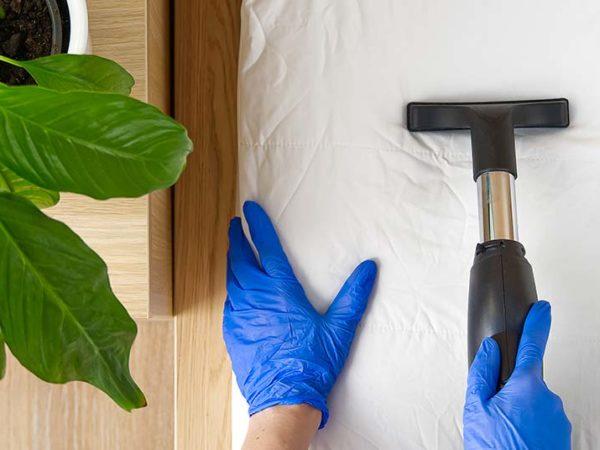
Dust mites are a common household pest. Most people will have to deal with dust mites at some point – they’re present in every country, with Antarctica as the only exception.
The good news is that it’s possible to get rid of dust mites in mattresses with some basic steps.
What are dust mites?
Dust mites are microscopic bugs that feed on dead skin cells. They’re called dust mites because dust is predominantly dead skin cells.
Dust mites are often found infesting mattresses and bedding where there’s a build-up of dead skin cells. They’re a common allergy and asthma trigger.
A few facts about dust mites
Dust mites are often confused with bed bugs, which are much bigger. Here are a few facts about dust mites:
- they live in soft furnishings, including mattresses, pillows, curtains and carpets
- they snack on dead skin cells
- they reproduce like crazy
- their faeces and dead bodies trigger allergic reactions
- they live in most climates
- they aren’t a sign of a dirty home
- most homes have them.
Dust mite symptoms and health effects
It can be hard to tell if dust mites are present because they aren’t visible to the naked eye.
Usually, symptoms are similar to allergens like pollen or dander. These can include sneezing, coughing, postnasal drip, stuffy nose, red and itchy skin, and itchy eyes.
If you’re unsure, a doctor will do an allergy test to determine if you’re allergic to dust mites.
Allergic reactions can be mild or severe, but dust mites also exacerbate asthma. The health effects should be taken seriously.
Debunking myths about dust mites
Dust mites can cause serious allergies and asthma attacks, but they’re otherwise fairly harmless. No one wants a bed full of dust mites, but it might soothe you to know there are quite a few myths about dust mites.
Dust mites are microscopic, so you can’t see them. They can’t fly – they only crawl – and they don’t crawl on you or burrow into your skin.
Unlike bed bugs and fleas, they don’t bite. And they don’t damage your bedding. They don’t live and breed in vacuum cleaners.
How to remove dust mites from mattresses
Dust mites can’t be completely eliminated, but reducing them will help prevent allergic reactions and asthma attacks.
Here are some ways that you can remove or reduce dust mites in mattresses.
Wash your bedding frequently
Dust mites can’t survive temperatures over 60°C. A regular hot cycle in the washing machine will kill any mites in your bedding.
Remove fitted carpets
Fitted carpets are a breeding ground for dust mites. If you struggle with allergies, remove them from the bedroom so the mites can’t move from the carpet to your mattress.
Reduce temperature and humidity
Dust mites can live in any temperature humans can, but they thrive in warm, humid conditions. Reduce the temperature and humidity of the bedroom to reduce their numbers.
Use blinds instead of heavy curtains
Much like carpets, heavy curtains can be a breeding ground for dust mites that will then migrate to your bed.
Deep clean your mattress periodically
Steam cleaning your mattress at least once a year will kill dust mites and reduce other allergens, such as pet dander.
Benefits of professional mattress cleaning
Professional steam cleaning is an effective way to get rid of dust mites in mattresses.
This is because of the high temperature reached during the cleaning process. The heat kills dust mites and other pests (including their eggs), as well as mould spores and pathogens like bacteria.
At Chelsea Cleaning, we offer professional deep cleaning of mattresses, as well as carpets, curtains and upholstery. Contact us online or call 021 761 1162 for information or a quote.



